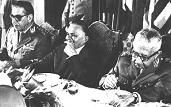By far the smallest arm of the IDF, the navy in 1987 consisted of about 1,000 officers and 8,000 enlisted personnel, including 3,200 conscripts. An additional 1,000 reserve personnel would be available on mobilization. The navy is not designated as a separate service. Officially known as the Sea Corps (Hel Yam), the navy enjoys more autonomy within the IDF structure than the official designation would suggest. The commander has the status of senior advisers to the chief of staff. Along with the ground force area commanders, the commander of the navy holds two-star rank.
Long neglected, the navy won acclaim for its successful engagements with the Syrian and Egyptian navies during the October 1973 War, when it sank eight Arab missile boats without the loss of a single Israeli vessel. The Soviet Union replaced Syria's wartime losses and provided an additional nine missile boats. The Egyptian fleet also introduced new and more advanced equipment after the 1973 conflict. With more than 140 units as of 1988, the Egyptian fleet was larger than that of Israel. Nevertheless, foreign observers believed that the balance of naval power still rested with Israel because of its technological and tactical superiority.
During the 1980s, sea infiltration by PLO terrorists presented the most immediate naval threat. With few exceptions the navy succeeded in thwarting such attacks, using missile boats to detect mother ships on the high seas, fast patrol craft for inshore patrolling, and offshore patrol aircraft for visual or radar detection of hostile activity. Nevertheless, Israeli defense planners accorded the navy the lowest priority among the IDF's three arms and, although it had been expanded, some Israeli defense experts warned that modernization was lagging behind that of the navies of the Arab states.
Although reduced in scope from earlier plans, a modernization program for the navy approved in 1988 included the acquisition of three Saar 5-class corvettes to be built in the United States and three Dolphin-class diesel submarines to be built in West Germany, and the upgrading of existing patrol boats. The 1,000-ton Saar 5s, which would be the most potent surface vessels in the fleet, would each be equipped with Harpoon and Gabriel missiles, as well as a helicopter. They would considerably enhance the navy's range and offensive capability.
In 1988 the fleet contained approximately seventy combat vessels, including three submarines, three missile-armed hydrofoils, twenty-two fast attack craft equipped with Israeli-built Gabriel missiles, and thirty-two coastal patrol boats. In assembling its fleet, the navy had shunned large vessels, preferring small ships with high firepower, speed, and maneuverability. The Reshef-class fast attack craft, the heart of the Israeli fleet, had a range of about 2,400 kilometers. The fleet operated in two unconnected bodies of water--on the Mediterranean Sea, where major naval ports were located at Haifa and Ashdod, and on the Gulf of Aqaba, with a naval facility at Elat. The first Reshefs were stationed in the Red Sea but were redeployed to the Mediterranean, via the Cape of Good Hope, after the return of the Sinai Peninsula to Egypt. As of 1988, the naval units protecting shipping on the Gulf of Aqaba were primarily Dabur-class coastal patrol boats.
The navy had not established a marine corps, although it had created an elite unit of about 300 underwater commandos who had proved to be highly successful in amphibious assault and sabotage operations. Its naval air arm was limited to maritime reconnaissance conducted with Israeli-produced Seascan aircraft and rescue and surveillance missions performed with Bell helicopters. With a moderate number of landing craft, Israel could deliver small forces of troops and armored equipment for beach landings in the eastern Mediterranean. This capability was demonstrated in June 1982, when these amphibious units successfully landed an assault force of tanks, armored personnel carriers, engineering equipment, and paratroops behind PLO positions near Sidon on the Lebanese coast.
Source
_____________________________________________________________
Submarines:
SSK Dolphin Class attack submarine
Gal
_____________________________________________________________
Patrol Boats:
Dabur
Dvora
Shaldag Mk II
Super Dvora Mk II
Super Dvora Mk III
Zivanit
_____________________________________________________________
Missile Boats:
Saar 3
Saar 4
Saar 4.5
Eilat Class Saar 5 multi-mission corvettes
_____________________________________________________________
Missiles:
Barak Ship Point Defense Missile System
Gabriel
_____________________________________________________________
Other Systems and Weapons:
Typhoon Naval Optronic Stabilized Weapon Platforms
NAVLAR NAVAL Artillery Rocket System
Protector Unmanned Naval Patrol Vehicle
EL/M-2221 STGR - Search, Track & Guidance/Gunnery Radar
Source:





